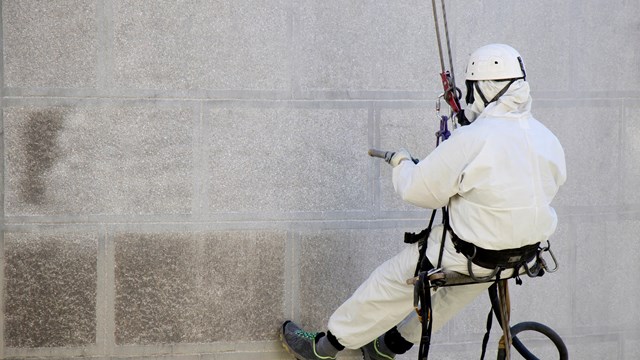A little over a year ago tennis star Vitas Gerulitas went to bed in a friend's pool house on Long Island and
never woke up. Unbeknownst to him, a faulty pipe was spewing a colorless, odorless, highly poisonous gas into the air and with each breath Gerulitas inhaled he got one step closer to death. This gascarbon monoxideis one of the many hidden dangers that could be lurking around the corner in your home. In addition to carbon monoxide, other dangers to watch for include asbestos, formaldehyde, freon and organic pollutants that reside in many of your household products.
Lead has received a lot of press lately but people forget it is not the only danger out there, says Jerry Picaso, president of Gerard J. Picaso, Inc., a residential property management firm in Manhattan. Although the list may seem formidable, you can greatly reduce your risk by developing an awareness of these hidden dangers and keeping an eye on the possible sources in your home.
Banned But Not Banished
Asbestos is a mineral fiber that was commonly used in a variety of building construction materials for insulation and as a fire-retardent until it was banned in the late '80s by the Environmental Protection Agency (EPA) and the United States Consumer Product Safety Commission (CPSC). Today, asbestos is most commonly found in older buildings, in pipe and furnace insulation materials, asbestos shingles, millboard, textured paints and other coating materials and floor tiles.
Elevated concentrations of airborne asbestos can occur after asbestos-containing materials are disturbed by cutting, sanding or other remodeling activities. Improper attempts to remove these materials can release asbestos fibers into the air in homes, increasing asbestos levels and endangering people living in those homes or coming in daily contact through common areas, says Antonia Gilligan, assistant lab director at Ambient Labs, a Manhattan-based company that specializes in the testing and development of environmentally safe products. The most dangerous asbestos fibers are too small to be visible. After they are inhaled, they can remain and accumulate in the lungs where they can cause the most damage.
Asbestos can cause lung cancer, mesothelioma (a cancer of the chest and abdominal linings) and asbestosis (irreversible lung scarring that can be fatal). Symptoms of these diseases often do not show up until many years after the exposure began. According to Gilligan, most people with asbestos-related diseases were exposed to elevated concentrations on the job and some developed diseases from exposure to clothing and equipment brought home from job sites.
Thankfully there are steps to take to reduce your exposure to asbestos. Usually it is best to leave asbestos material that is in good condition alone. There is no danger unless fibers are released and inhaled into the lungs. Also prevent the undamaged material from being damaged by limiting access to the area, and of course periodically inspect for damage. If the material is damaged, or you will be planning to do some work in the area, call in a professional to remove or contain the asbestos.
Difficult to Detect
Unlike asbestos, which tends to be more of a building-wide issue, carbon monoxide is a problem that usually affects individual apartments. Carbon monoxide deaths are quite common but are publi ffb cized only in cases when a well-known figure like Gerulitas dies. Unlike lead and asbestos, carbon monoxide is more difficult to detect because it is odorless and tasteless. Most people associate carbon monoxide poisoning with the exhaust emitted from cars, but the deadly gas can be emitted from unvented kerosene and gas space heaters; leaking chimneys and furnaces; back-drafting from furnaces, gas water heaters, wood stoves, fireplaces and gas stoves.
According to Steve Wolfson of Environmental Testing, a Long Island-based environmental disposal company, there are certain levels of carbon monoxide to keep your eye on. The average levels in homes without gas stoves vary from .05 to five parts per million (ppm). The levels near properly adjusted gas stoves are often five to 15 ppm and those near poorly adjusted stoves may be 30 ppm or higher, explains Wolfson. Ideally you want to keep these levels as low as possible.
At low concentrations, carbon monoxide can cause fatigue in healthy people and chest pain in people with heart disease. At higher concentrations it can impair vision and coordination, cause headaches, dizziness, confusion and nausea. It can also cause flu-like symptoms that will clear up after you leave the contaminated area. And of course at very high concentrations carbon monoxide can be fatal.
Steps to reduce exposure are quite simple. Keep gas appliances properly adjusted. This includes making sure there are no gas leaks and that the proper amount of gas is flowing into the stove. To make sure that your stove is properly adjusted call Con Edison or a reputable appliance service man. Consider purchasing a vented space heater when replacing an unvented one and use proper fuel in kerosene space heaters. Install and use an exhaust fan vented to the outdoors or ducts over gas stoves. Open flues when fireplaces are in use. Choose properly sized wood stoves that are certified to meet EPA emission standards. Make sure that the doors on all wood stoves fit tightly and repair broken glass on the doors as soon as possible. Have a trained professional inspect, clean and tune up central heating systems (furnaces, flues and chimneys) annually and repair any leaks promptly.
It is also important to note that people using gasoline-powered tools such as high-pressure washers, concrete cutting saws (walk-behind/hand-held), power trowels, floor buffers, welders, pumps, compressors and generators in buildings or semi-enclosed spaces have been poisoned by carbon monoxide, according to the EPA and the Occupational Safety and Hazard Administration (OSHA).
I highly recommend a carbon monoxide detector that will sound an alarm if carbon monoxide levels exceed a safe level, says Wolfson. These devises can be found at hardware stores and anyplace where smoke detectors are sold. Nowadays fire detectors also contain a carbon monoxide detector. But for $40 you can't go wrong with making sure you are safe with one of these devises.
A Source of Irritating Emissions
Formaldehyde is something we most often associate with science projects from our high school days; but, surprisingly, formaldehyde is commonly used in a lot of our furniture and building materials. This colorless, pungent chemical used to manufacture building materials and numerous household products can be found in building materials, tobacco smoke, household products and the use of unvented, fuel-burning appliances like gas stoves or kerosene space heaters. Formaldehyde, by itself or in combination with other chemicals, serves a number of purposes in manufactured products. For example it can be used to add permanent-press qualities to clothing and draperies, as a component of glues and adhesives and as a preservative in some paints and coating products.
In homes, the most significant sources of formaldehyde are likely to be pressed wood products made using adhesives that contain urea-formaldehyde (UF) resins, explains Barry Maher, vice president of H & S Environmental, an environmental product testing and disposal company based in Manhatta ffb n. Pressed wood products made for indoor use include particleboard (used as subflooring and shelving in cabinetry and furniture); hardwood plywood paneling (used for decorative wall coverings, cabinets and furniture); and medium density fiberboard (used for drawer fronts, cabinets and furniture tops). Medium density fiberboard contains a higher resin-to-wood ratio than any other UF pressed wood product and is generally recognized as being the highest formaldehyde-emitting pressed wood product.
The rate at which products like pressed wood or textiles release formaldehyde can change, Maher states. Formaldehyde emissions will generally decrease as products age. When the products are new, high indoor temperatures or humidity can cause increased release of formaldehyde from these products.
Formaldehyde can cause watery eyes, burning sensations in the eyes and throat, nausea and difficulty in breathing for some people exposed at elevated levels above one ppm. High concentrations may trigger attacks in people with asthma and there is evidence that some people can develop a sensitivity to formaldehyde. It has also been shown to cause cancer in animals and may cause cancer in humans.
Although the risk and exposure to formaldehyde is rare, it is still important to be educated when purchasing pressed wood products, explains Maher. This can be done by simply asking about the formaldehyde content before purchasing these materials. Maher suggests using exterior-grade pressed wood products because they use PF resins that are lower-emitting. Use air-conditioners and dehumidifiers to maintain moderate temperature and reduce humidity levels that can emit formaldehyde. Increase ventilation, particlulary after bringing new sources of formaldehyde into the home.
A Banned Pollutant
Although freon has been a banned chemical in the United States for some time now, you may still be exposed to it. If you have an old window air conditioner chances are it contains freon. Matthew Stock, vice president of Manhattan-based GAC Environmental suggests that you consider replacing the entire unit. In addition to containing a pollutant, the unit just isn't worthwhile keeping, efficiency wise. Stock also mentions that when disposing of your old air conditioner you need to have the freon professionally removed.
This can be done by calling any environmental company. If they don't do that type of removal on a small scale they should be able to recommend someone who does. When the freon is removed a special tag will be placed on the unit so that garbage disposal workers will know that it is safe to pick up. Without that tag it will not be picked up. If your building has a central air system that used to rely on freon, chances are the system is now using freon substitutes that meet requirements set by the EPA. You can be fined by the EPA if the coolant is still being replaced with freon, although it is nearly impossible to find companies that still sell it, explains Scott.
Monitoring Organic Pollutants
Organic chemicals are widely used as ingredients in household products such as paints, varnishes, wax, cleaning and hobby products. The EPA's Total Exposure Assessment Methodology (TEAM) studies found levels of about a dozen common organic pollutants, like household cleansing products, to be two to five times higher inside homes than outside. Additional TEAM studies indicate that while people are using products containing organic chemicals, they can expose themselves and others to very high pollutant levels, Gilligan says. In addition, these elevated concentrations can persist in the air long after the activity is completed.
The ability of organic chemicals to cause health problems varies greatly from those that are highly toxic to those with no known health effect. As with other pollutants, the extent and nature of the health effect will depend on many factors including level of exposure and length of time exposed. Eye and respiratory tract irritation, headaches, dizziness, visual disorders and memory impairment are a d2c mong the immediate symptoms that some people experience.
To limit the exposure to household chemicals be sure to follow the instructions on the label carefully, throw away partially full containers of old or unneeded chemicals safely, keep exposure from products containing methylene chloride and benzene to a minimum, provide plenty of fresh air when using the products and most importantly never mix household products unless directed on the label.
Ask the Experts
If you are unsure about any product your best bet is to call the EPA. They have many educational tools and special help lines that can assist you in making sure you are safe from hazardous materials. If you have any questions regarding asbestos in the building or anything regarding the furnace or central cooling system you can always ask the super or the managing agent, says Picaso.
The idea is not to scare people, adds Maher. For the majority of people the amount of exposure is incredibly limited. The main three to keep an eye on are lead, asbestos and carbon monoxide, but all the others are just as important if they are not monitored. But when everything is kept in check the amount of danger is dramatically decreased.
Ms. Cooper is Editorial/Internet Coordinator of The Cooperator.







9 Comments
Leave a Comment